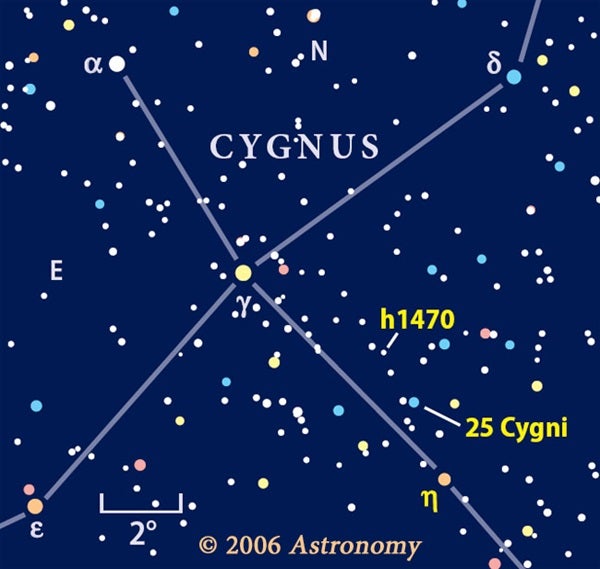“But there is a sky object named for you,” one friend noted.
“Really? Which one?” I replied.
“The Dumbbell Nebula!” he retorted to a chorus of laughter.
“Ha, ha, ha. Very funny!” What my unsympathetic friends don’t realize is a piece of cosmic real estate does have my name on it — even though the IAU doesn’t sanction it. It’s called “Chaple’s Arc.”
In my early years as an amateur astronomer, I was a double-star fanatic. After being smitten by a view of the showpiece pair Mizar (Zeta [z] Ursae Majoris), I set out on a crusade to observe every double star within the reach of my 3-inch reflecting telescope. I began my constellation-by-constellation hunt for stellar pairs guided by Norton’s Star Atlas and Webb’s Celestial Objects for Common Telescopes — which, despite being written in the late 1800s, has useful lists of double stars.
During late summer 1972, I was working on a list of targets in Cygnus. One of my targets was h1470 — number 1,470 out of more than 5,500 double stars cataloged by John Herschel during the early decades of the 19th century. Webb commented on the primary star’s ruddy color and explained how a spacious 29″ (arcseconds) separate the magnitudes 7 and 9 component stars. Using Eta (η) Cygni as a starting point, I star-hopped 2° north and slightly east to 25 Cygni. Continuing another degree brought me to h1470. I marveled at what I saw through the eyepiece. So many stars looked double, I thought my scope’s mirror might have cracked. After realizing my scope was fine, I gazed in astonishment at four double stars arranged in a ½° arc. I wrote in my logbook:
Four summers passed before I returned to the area. This time, I was a more experienced observer, able to single out h1470. I could also make reasonable estimates of the magnitudes and separations of the remaining three doubles. Each sports a primary star of 7th or 8th magnitude, whose 9th-magnitude companion is 30″ to 45″ away.
I described this fascinating group in a “Double Stars of the Month” column in the September 1980 issue of Deep Sky Monthly (whose cover showed a photo of the Dumbbell Nebula). After reading the article, amateur astronomer John Pazmino viewed the h1470 group from New York’s light-polluted skies and wrote the following piece in the October 1980 Eyepiece — the newsletter of the Amateur Astronomers Association.
“Back in Brooklyn, I found Chaple’s Arc with my Dynamax-8 and lo: it’s a startling sight! There, around an arc about ½° in diameter are four beautiful double stars! From Manhattan I examined the group through my Questar, and even though the air was somewhat soupy, the arc stood out plainly even under both 40 and 80 power.
“Urbanites will delight over this array. The four main members are all bright and widely separated. With Cygnus with us through the end of the year, Chaple’s Arc will offer yet a few more months of fascinating viewing.”
Why, you may well ask, should the tale of Chaple’s Arc appear in a column for beginners? Simple. You’ll have to star-hop to find the Arc, and that’s a skill the novice telescopist needs to learn. Its location in a rich Milky Way field adds a dimension of difficulty to the hop.
Recently, I visited h1470 — this time with a 13-inch Dob. A clutter of faint background stars detracted from the visual impact of the Arc. A quick check with my faithful little 3-inch reflector confirmed my suspicion that Chaple’s Arc is most impressive when viewed with a small-aperture scope (or a large scope in a light-polluted area). Check it out, and let me know what you think.











